Testis cancer, or testicular cancer, is a type of cancer that occurs in the testicles of men. The testicles are located in the scrotum, underneath the penis, and are responsible for the production of the male sex hormone and sperm.
It is estimated that about 8000 to 10000 men suffer from testis cancer every year in the United States. It may sound frightening, but with early detection, the chances of beating testis cancer are actually really high.

Some symptoms of testis cancer to look out for include:
The first symptom of testicular cancer is usually a lump or swelling of the testicles. Most of the time, lumps or swelling caused by testicular cancers are painless.
You should visit a doctor if you have any of the above symptoms. Early detection leads to early treatment and can greatly increase the chances of cure.
The lump often forms within the testicle and feels hard. It may also feel firmer and more swollen than usual. The shape of the testicle can also change.
Stages of testis cancer are determined based on 4 main factors:
The different stages of testis cancer are summarised in the table below:
Stage I
Stage IA
Stage IB
Stage IS
Stage II
Stage IIA
Stage IIB
Stage IIC
Stage III
Stage IIIA
Stage IIIB
Stage IIIC
Testicular cancer usually spreads to the lungs, lymph nodes of the chest, pelvis and the base of the neck.
There is currently no known cause for testis cancer. However, there are certain factors that can increase someone’s risk of developing testis cancer. These factors include:
Testis cancer can be diagnosed through a series of tests such as:
There is nothing special that you will need to prepare before going for your first consultation. Your doctor may ask about your family history to help him in his diagnosis.
Testicular cancer is diagnosed with histological diagnosis – tissues placed under the microscope for examination. Although there are blood tests to predict the risk and severity of testicular cancer, these blood tests are not considered diagnostic of testicular cancer. Not all patients with testicular cancer will produce elevated levels of tumour markers.
There are different treatments available that your doctor may recommend, either singly or in combination, depending on your condition.
Chemotherapy involves the use of drugs to treat cancer by destroying the cancer cells. It is usually used when the cancer has spread outside of the testes or to help consolidate treatment after surgery.
The standard treatment for the removal of testis cancer is a radical inguinal orchiectomy. This surgery involves the removal of the entire testicle and spermatic cord, and chances of making a full recovery are high. Chemotherapy is often required after surgery. The involved lymph nodes may also be required to be removed.
A testicular prosthesis may be offered as an option and is a personal decision.
Radiation therapy uses high doses of X-rays to kill cancer cells. This is typically used for certain types of testicular cancer after surgery to the nearby lymph nodes to reduce the recurrence of cancer.
Yes, testis cancer is curable. Early detection is key in the treatment of testis cancer. Testis cancer is treated successfully in more than 95% of cases.
A radical orchiectomy involves the removal of the testicle and spermatic cord through an incision made in the groin. On the other hand, a simple orchiectomy involves removing the testicle through the scrotum. A simple orchiectomy is not the ideal surgery to treat testicular cancers.
Yes, you can. Generally, one testicle can provide enough testosterone and sperm for pregnancy. However, with chemotherapy or radiotherapy, the sperm may be affected. Sperm banking can be considered in these circumstances. Having one testicle does not affect your ability to get an erection.
Early detection of testis cancer entails early treatment and good outcomes. If you experience a painless lump or swelling in your testicles, please visit your urologist for a comprehensive diagnosis and a personalised treatment plan.

MBBS, MRCSed, MMED(Surgery)
Dr Terence Lim is a Senior Consultant Urologist with a subspecialty in Uro-Oncology. He is also the Medical Director at Assure Urology & Robotic Centre. His clinical interests include Uro-Oncology, Minimally-invasive Urological Surgery, Urinary Stone Disease, Endourology and Prostate Health.
Prior to his private practice, Dr Terence Lim spent almost two decades in public healthcare. He served as the Senior Consultant and Chief of the Department of Urology at Changi General Hospital (CGH). In addition, he is currently a Visiting Consultant at CGH. Dr Lim was also the director of CGH’s Advanced Surgical Centre, a committee dealing with complex surgeries, including robotic surgeries.
Your health is important to us and some conditions require immediate attention. For emergencies, please contact us at 9835 0668.

MBBS, MRCSed, MMED(Surgery)
Dr Terence Lim is a Senior Consultant Urologist with a subspecialty in Uro-Oncology. He is also the Medical Director at Assure Urology & Robotic Centre. His clinical interests include Uro-Oncology, Minimally-invasive Urological Surgery, Urinary Stone Disease, Endourology and Prostate Health.
Prior to his private practice, Dr Terence Lim spent almost two decades in public healthcare. He served as the Senior Consultant and Chief of the Department of Urology at Changi General Hospital (CGH). In addition, he is currently a Visiting Consultant at CGH. Dr Lim was also the director of CGH’s Advanced Surgical Centre, a committee dealing with complex surgeries, including robotic surgeries.
Your health is important to us and some conditions require immediate attention. For emergencies, please contact us at 9835 0668.
No issue is too small. Contact any of our friendly staff and we will get back to you as soon as possible.
Reach out to us for expert urological care.
For enquiries, leave a message and our friendly team will get in touch with you.
For urgent enquiries after office hours, call or WhatsApp us at (65) 9835 0668.
Monday – Friday: 9:00AM – 5:00PM
Saturday: 9:00AM – 12:30PM
Sunday & Public Holiday: CLOSED

© 2023 All Rights Reserved | Assure Urology & Robotic Centre | Terms & Conditions